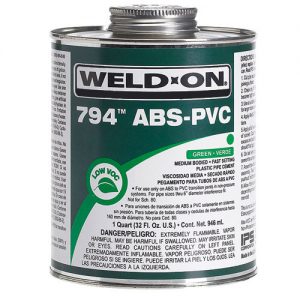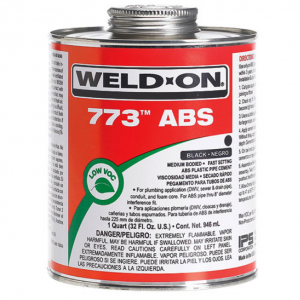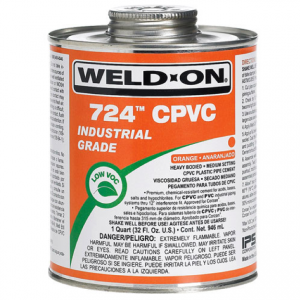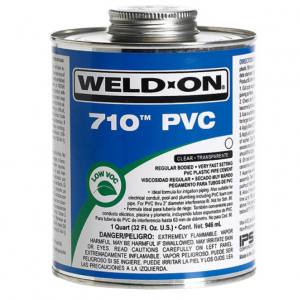Today’s plastic piping is made to last for decades, but an improperly sealed joint can fail under the right conditions. By joining pipes correctly the first time, plumbers can build a reputation for quality that leads to long-term customer relationships.
If you work in the plumbing industry, then you’re most likely familiar with plumbing cement. If nothing else, you probably have an old can at the back of the shelf. But do you know which type of plumbing cement to choose for which job? Not all cements are created for every pipe.
Which Plumbing Cement Do You Choose?

First off, let’s talk about what plumbing cement isn’t. Although it’s sometimes referred to as plumbers glue or plumbing glue, plumbing cement is not a glue. Glues create a bond between substrates by adhesion. But, over time, glues dry out and their adhesive properties degrade—this is not ideal for plumbing applications where leaks can occur.
A solvent-based cement creates a seal via chemical fusion. When you apply plumbing cement, it starts by reacting with the plastic pipe and softening it a little. Connecting the two parts of the joints together while the plastic is still soft means that the entire pipe will reform and solidify as, essentially, one continuous piece.
It’s an effective solution, but there are a lot of different types of cement on the market. Even individual manufacturers will make several plumbers cement products to accommodate the various demands of each job.
When picking a plumbing cement, make sure you consider the following elements of your job so you pick the right product:
- Plastic type
- Pipe diameter
- Pipe contents
- Pressure
- Temperature
In general, plumbing cement comes in three general types: Heavy, Medium, and Regular (sometimes referred to as Light). This speaks, in general terms, to the viscosity of the plumbers cement. More viscous cements have a higher resin content, leading to a thicker formulation. So while Light plumbers cement is a great all-purpose option for smaller pipe diameters with smaller gaps, Heavy plumbing cement should be used for bigger pipes or when other conditions are met.
Let’s talk about those conditions.
Plastic Type
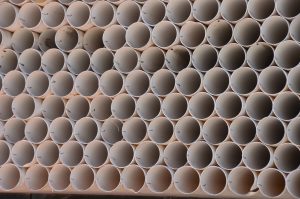
Plumbing pipe typically comes in one of three types of plastic:
- Polyvinyl chloride (PVC)
- Chlorinated polyvinyl chloride (CPVC)
- Acrylonitrile butadiene styrene (ABS)
The type of plastic required for a particular plumbing job is determined by local building codes and considers factors like what will be carried through the pipe, the temperature and whether it will be under pressure.
Each type of plastic has a different chemical formulation, and so each type also needs a specific formulation of plumbing cement to react to it and get the proper seal. Suppliers like IPS’s Weld-On have different formulations for PVC, CPVC and ABS pipe.
Pipe Diameter
Once you’ve identified the type of plastic you’ll need to use for your project, spec out the diameter required. This is often the first differentiator when choosing a Heavy, Medium or Regular plumbing cement.
For example, Weld-On Regular-Bodied Plumbing Cement for PVC is rated as being appropriate for jobs up to four inches in diameter, while the Medium-Bodied PVC Plumbing Cement is rated for six inches for most types of jobs and four inches for Schedule 80 pipe (see the Pressure section below for more details), and the Weld-On Heavy-Bodied Plumbing Cement for PVC is rated for pipe diameters up to twelve inches.
Heavy-bodied cement is thicker, so if you’re connecting a larger diameter pipe and fitting they will have a larger gap between them, so you will need to use heavy-bodied cement to make sure they bond properly.
Pipe Contents
What materials will be flowing through your pipes will be part of determining the type of plastic you can use, as well as which Weld-On materials are most appropriate.
All plumbing applications involve water. For applications involving chemicals through the pipe, IPS Weld-On does offer Weld-On CPVC 724 Heavy-Bodied Cement. Contact IPS or your local Weld-On dealer for more information.
Pressure
You also should consider whether the pipes will carry materials flowing by gravity or under pressure. FlowGuard Gold cement is designed for small diameter pressure-fed CPVC supply lines. If you’re working on a pressure-fed system, speak to your Weld-On supplier for solutions to make sure your work lasts.
Certain pipes are designed specifically for high-pressure applications. The walls on Schedule-80 rated PVC pipe are thicker than those of Schedule-40 pipe, so they can handle higher pressure. As a result, you may need to use a thicker/stronger cement on Schedule-80 pipe than you would on a Schedule-40 pipe of the same diameter to make sure it properly sealed.
Temperature
CPVC pipe has become a go-to material for hot water systems, and so CPVC plumbers cement is designed to last at higher temperatures. Weld-On materials for CPVC like 713 Low-VOC CPVC cement, and FlowGuard Gold are rated for hot water temperatures up to 170℉.
Temperature also comes into play in terms of the ambient temperature while you’re cementing your plumbing joints. Typically, a heavier-bodied cement takes longer to set than a medium- or regular-bodied option, though all types will set faster in warmer temperatures. So if you’re working in a hot area of a facility or outside on a hot day, consider upgrading to a medium- or heavy-bodied option if you need more time to get your joints in place.
Weld-On PVC 727 Hot ‘R Cold Medium Bodied Cement is rated for ambient temperatures ranging from -15℉ to 110℉.
Which Cement Is Right for You?
There are many factors to consider when choosing the right plumbing cement. Weld-On Plumbing Cement comes in a variety of formulations to suit many purposes. Make sure you have all the information about your job, then contact Weld-On or your local distributor to find the product that will work best with your needs.
